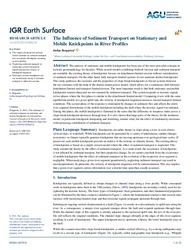The Influence of Sediment Transport on Stationary and Mobile Knickpoints in River Profiles
DOI: https://doi.org/10.1029/2021JF006218
Persistent URL: http://resolver.sub.uni-goettingen.de/purl?gldocs-11858/9834
Persistent URL: http://resolver.sub.uni-goettingen.de/purl?gldocs-11858/9834
Hergarten, Stefan, 2021: The Influence of Sediment Transport on Stationary and Mobile Knickpoints in River Profiles. In: Journal of Geophysical Research: Earth Surface, Band 126, 12, DOI: 10.1029/2021JF006218.
 |
Dokument öffnen: |
The analysis of stationary and mobile knickpoints has been one of the most powerful concepts in tectonic geomorphology for decades. While several models combining bedrock incision and sediment transport are available, the existing theory of knickpoints focuses on detachment‐limited erosion without consideration of sediment transport. On the other hand, fully transport‐limited systems do not maintain distinct knickpoints. This study addresses the existence and the properties of slope‐break knickpoints in fluvial systems between the two extremes with the help of the shared stream‐power model, which allows for a continuous shift between detachment‐limited and transport‐limited erosion. The most important result is that both stationary and mobile knickpoints remain sharp and are not smeared by sediment transport. The system responds to tectonic signals in two phases where the first phase is similar to the detachment‐limited model. Comparing rivers with the same equilibrium profile at a given uplift rate, the velocity of knickpoint migration increases toward transport‐limited conditions. The second phase of the response is dominated by changes in sediment flux and affects the entire river segment downstream of the mobile knickpoint including the fault where the tectonic signal was initiated. During this phase, the mobile knickpoint is flattened in the sense that the difference in steepness index across a slope‐break knickpoint decreases through time. It is also shown that large parts of the theory for the nonlinear model, in particular knickpoint sharpening and stretching, remain valid, but the effect of nonlinearity decreases with increasing contribution of sediment transport. Plain Language Summary:
Knickpoints are either breaks in slope along a river or even almost vertical steps, or waterfalls. While knickpoints can be generated by a variety of phenomena, sudden changes in tectonics or climate typically generate knickpoints that are moving upstream over geological time scales. If preserved, such mobile knickpoints provide an archive of the tectonic or climatic history. The existing theory of knickpoints is based on a simple erosion model where the effect of sediment transport is neglected. This study extends the theory by the effect of sediment transport. As a main result, the occurrence of knickpoints is not affected by sediment transport, but their properties change. So we cannot conclude from the occurrence of mobile knickpoints that the effect of sediment transport on the evolution of the respective river segment is negligible. When analyzing a given river segment quantitatively, neglecting sediment transport can result in misinterpretations. In particular, the velocity of knickpoint migration will be underestimated. This also implies that a given river segment carries information over a shorter time span than usually assumed. Key Points:
The simple stream power incision model extended by sediment transport does not predict knickpoint smearing in river profiles.
Neglecting sediment transport in analyzing a given river profile underestimates the velocity of knickpoint migration.
Stationary tectonic knickpoints are not immediately steady if sediment transport is taken into account.
Statistik:
ZugriffsstatistikSammlung:
- Geologie [933]
This is an open access article under the terms of the Creative Commons Attribution License, which permits use, distribution and reproduction in any medium, provided the original work is properly cited.

